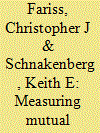|
|
|
Sort Order |
|
|
|
Items / Page
|
|
|
|
|
|
|
| Srl | Item |
| 1 |
ID:
135919


|
|
|
|
|
| Summary/Abstract |
Based on rational choice theory, this essay develops a theoretical approach to explain how an individual's expected utility of protesting is affected by the probability of having a new government, together with the expected costs, expected benefits, and the probability of retributive consequences for protesting. The essay argues that the probability of having a new government is positively correlated with the opposition's ability to coordinate. By modeling how these variables interact, this essay revises the concept of a “threshold,” or point where the expected net benefits exceed the expected costs of joining a rebellion. The concepts of “bandwagon” and “reverse bandwagon effect,” introduced by traditional models of collective behavior, are integrated to explain the dynamics of a revolution and how popular disaffection may lead to regime change. The resulting theoretical framework is then applied to analyze the unexpected escalation in the number of protests and the movement's subsequent dissolution that took place in Venezuela during the first months of 2014.
|
|
|
|
|
|
|
|
|
|
|
|
|
|
|
|
| 2 |
ID:
134459


|
|
|
|
|
| Summary/Abstract |
This study explores the relationships between state violations of different human rights. Though most quantitative studies in international relations treat different types of repressive behaviors as either independent or arising from the same underlying process, significant insights are gained by conceptualizing different human rights violations as separate but dependent processes. We present a theoretical framework for conceptualizing the mechanisms relating human rights practices and produce a novel measurement strategy based on network analysis for exploring these relationships. We illustrate high levels of complementarity between most human rights practices. Substitution effects, in contrast, are occasionally substantial but relatively rare. Finally, using empirically informed Monte Carlo analyses, we present predictions regarding likely sequences of rights violations resulting in extreme violations of different physical integrity rights.
|
|
|
|
|
|
|
|
|
|
|
|
|
|
|
|
| 3 |
ID:
134629


|
|
|
|
|
| Summary/Abstract |
Cross-border integration is a multifaceted as well as contextually contingent process. While various conceptualisations have been developed, the theoretical foundations of the concept appear insufficient in order to grasp the very significance of such a process of cross-border regionalism. In order to help make sense of the diversity of configurations observed, this article seeks to deconstruct the concept according to the role played by the border as a resource and to develop a theoretical framework based on two contrasted models of cross-border integration. The underlying hypothesis is that cross-border integration does not derive from the mere opening of national borders that it supposedly helps at the same time to remove, but stems from the strategic behaviour of actors who actively mobilise borders as resources. The first model, called ‘geo-economic’, is mainly based on the mobilisation of the border as a differential benefit and aims to generate value out of asymmetric cross-border interactions. In doing so, this process of functional integration is likely to increase cross-border socio-economic disparities and leads to cooperation oriented towards instrumental purposes such as increasing the economic utility of the border or regulating negative externalities. The second model, called ‘territorial project’, emphasises the border resources that involve a convergence of both sides of a border, either through a process of hybridisation/innovation or via the territorial and symbolic recognition borders entail. In this process of place-making that transcends the border, mutual understanding and trust between the actors is seen to be key and the willingness to cooperate essential. Conceived as ideal-types, the two models of cross-border integration are contrasted and to some extent contradictory. They are however not mutually exclusive and different kinds of combinations are examined based on concrete examples.
|
|
|
|
|
|
|
|
|
|
|
|
|
|
|
|
| 4 |
ID:
134608


|
|
|
|
|
| Summary/Abstract |
Possible links between climate change and intra-state violent conflict have received major scholarly attention in recent years. But with few exceptions there is still a low level of consensus in this research field. The article argues that one reason for this disagreement is a lack of integrative cumulation of knowledge. Such an integrative cumulation is prevented by three obstacles, which have until now hardly been discussed in the literature. The first is the use of inadequate terms, discussed here with a focus on the labels ‘Malthusian’/‘cornucopian’ and the operationalization of key variables. Secondly, the weaknesses of large-N studies in research on climate change and violent conflict are not sufficiently reflected. These include a lack of data on crucial concepts as well as deficits of widely used datasets. Thirdly, literature that deals with a possible link between adverse environmental change and peace (termed here ‘environmental peace perspective’) has neither been systematized nor adequately considered in the debate so far. The article provides examples of these shortcomings and makes suggestions of how to address each of them. It also develops an integrative theoretical framework for the environmental peace perspective which facilitates its consideration in research on climate change and violent conflict.
|
|
|
|
|
|
|
|
|
|
|
|
|
|
|
|
|
|
|
|
|